Sixteen burials found in rock-cut tombs have been discovered at the archaeological site of Taposiris Magna, west of Alexandria, Egypt. One of the mummies kept a gold leaf in the mouth.
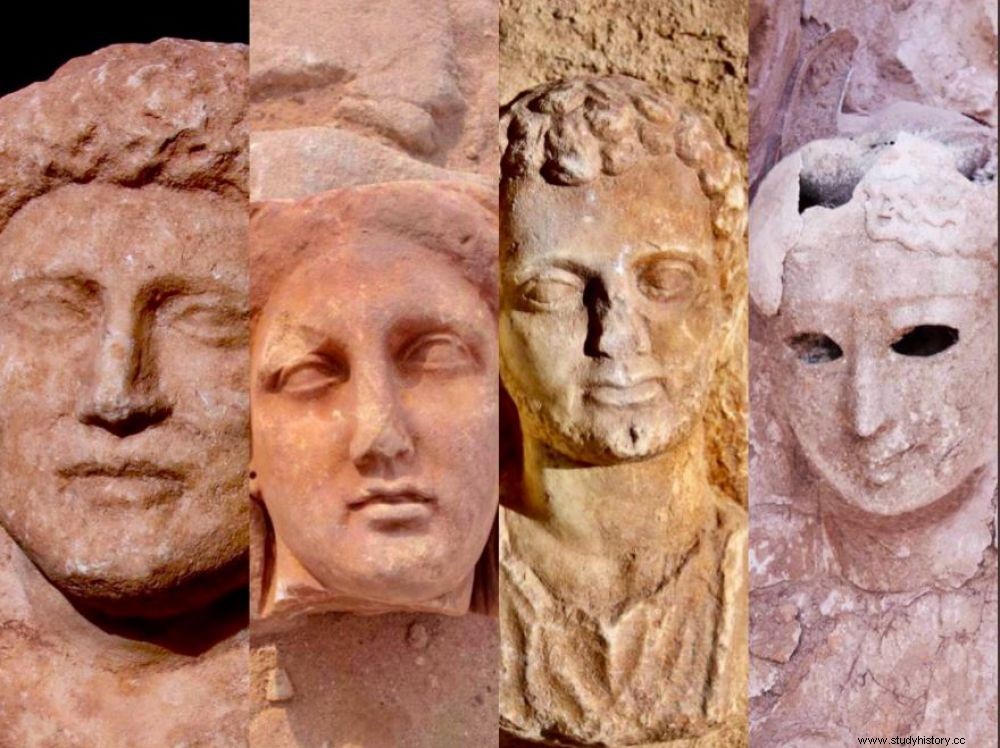
Funerary statues and masks discovered at Taposiris Magna (Egypt).
2000-year-old faces resurrected from Antiquity... The archaeological mission led by Dominican Egyptologist Kathleen Martinez has just brought to light several delicate Greco-Roman remains.
The discovery of 16 burials in tombs carved into the bedrock
In its publication of January 29, 2021, the Egyptian daily Luxor Times reported the discovery of 16 burials in tombs carved into the bedrock that encloses the site of Taposiris Magna and its temples dedicated to Isis and her brother-husband Osiris, on the north shore of Lake Mariout (ancient Mareotis), in 45 km west of Alexandria. A vast sanctuary that has been tirelessly explored since 2005 by this specialist from the Dominican Republic in the Caribbean.
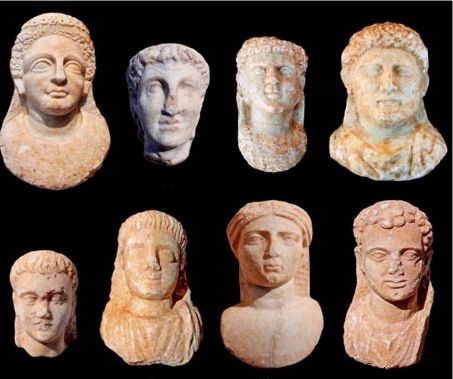
Detail of eight funerary statuettes found in tombs dug into the rocks of Taposiris Magna, in Egypt. ©Ministry of Tourism and Antiquities/Kathleen Martinez.
Besides eight beautiful marble heads from the Greco-Roman period, a funerary mask partly covering a female remains; a fan of gold leaf probably from a crown, and some mummies in a poor state of preservation have been exhumed. As well as golden cardboard elements and amulets.
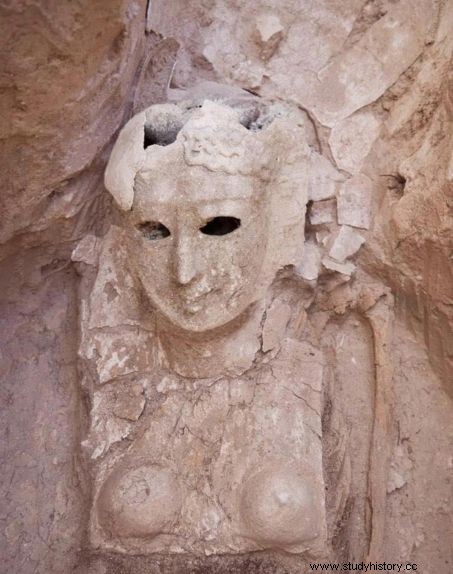
Funeral mask partially covering a mummy. ©Ministry of Tourism and Antiquities/Kathleen Martinez.
A "golden tongue" in the mouth of the deceased
2000-year-old faces resurrected from Antiquity... The archaeological mission led by Dominican Egyptologist Kathleen Martinez has just brought to light several delicate Greco-Roman remains.
The discovery of 16 burials in tombs carved into the bedrock
In its publication of January 29, 2021, the Egyptian daily Luxor Times reported the discovery of 16 burials in tombs carved into the bedrock that encloses the site of Taposiris Magna and its temples dedicated to Isis and her brother-husband Osiris, on the north shore of Lake Mariout (ancient Mareotis), in 45 km west of Alexandria. A vast sanctuary that has been tirelessly explored since 2005 by this specialist from the Dominican Republic in the Caribbean.

Detail of eight funerary statuettes found in tombs dug into the rocks of Taposiris Magna, in Egypt. ©Ministry of Tourism and Antiquities/Kathleen Martinez.
Besides eight beautiful marble heads from the Greco-Roman period, a funerary mask partly covering a female remains; a fan of gold leaf probably from a crown, and some mummies in a poor state of preservation have been exhumed. As well as golden cardboard elements and amulets.

Funeral mask partially covering a mummy. ©Ministry of Tourism and Antiquities/Kathleen Martinez.
A "golden tongue" in the mouth of the deceased
One of these precious talismans - qualified by some as a golden tongue - was still in the mouth of a deceased. A ritual that could have allowed the dead to address the gods in the afterlife, according to a press release from the Egyptian Ministry of Tourism and Antiquities. This announcement also specified that fragments of parchments found near two mummies were being studied.
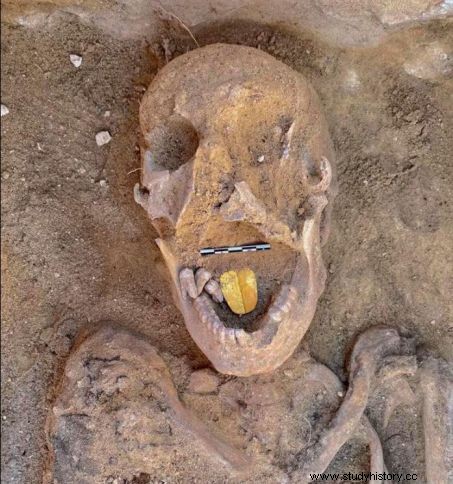
The deceased with the "golden tongue"©Ministry of Tourism and Antiquities/Kathleen Martinez.
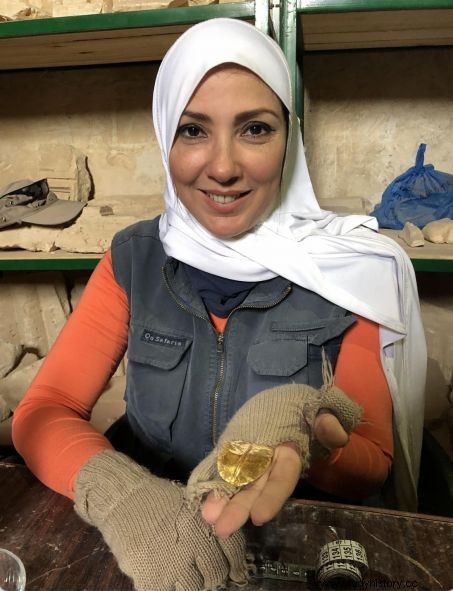
Egyptologist Kathleen Martinez holding the golden tongue in her hand. ©Kathleen Martinez for Sciences et Avenir
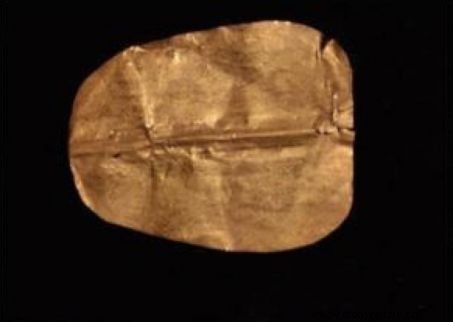
Zoom in on the golden tongue. ©Kathleen Martinez for Sciences et Avenir
Year after year, Kathleen Martinez auscultates the smallest nooks and crannies of this important site nestled at the top of a rocky limestone ridge. In particular, she searched there - in vain until now - for the tomb of Cleopatra VII, the legendary queen of Egypt who died in 30 AD. Taposiris Magna has also delivered hundreds of objects in the past, including granite and bronze statues, as well as numerous coins bearing the image of the illustrious sovereign.
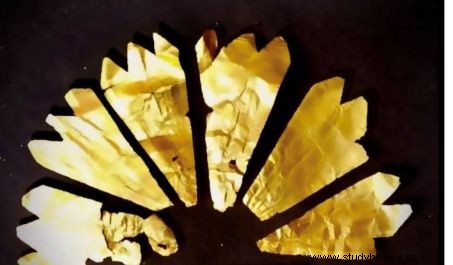
Gold leaves from a wreath collected from one of the tombs. ©Ministry of Tourism and Antiquities/Kathleen Martinez.
In 2011, Sciences et Avenir went to meet this archaeologist (read Special Edition January-February 2011 ). On this occasion, we presented the majestic ruins of this set of monuments visited from 1801 by the scholars who accompanied Bonaparte during the Egyptian Campaign (1798-1801).
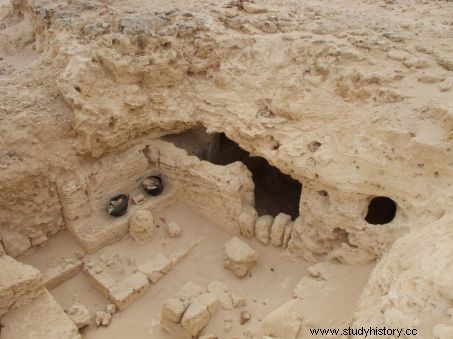
Example of tombs carved into the rock such as can be found on the site of Taposiris Magna. ©Bernadette Arnaud / Science and Future
Kathleen Martinez's work has long been supported by the famous Stetson Egyptologist, Zahi Hawass, who very recently withdrew from the excavation project, now convinced that the burial of Cleopatra VII would never be found in this place. In the meantime, Greco-Roman remains from the reign of the last of the Ptolemies (304-30 BC) continue to be unearthed. Director General of Antiquities of Alexandria, Khaled Abul Hamd, said the main archaeological finds discovered at the Temple of Taposiris Magna have been transferred to the National Museum of Alexandria.
